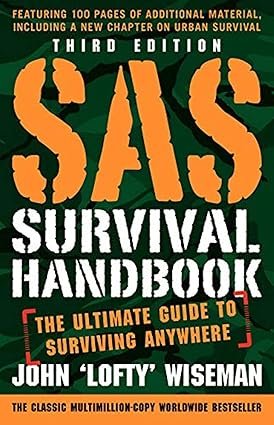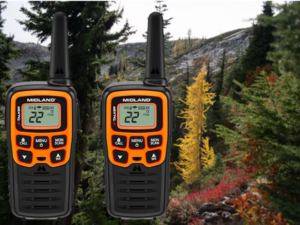Introduction to the SAS Survival Handbook
If you’re serious about surviving and thriving outdoors—whether you’re braving mountain trails, desert heat, or navigating a stormy night—the legendary SAS Survival Handbook is a must-pack essential. Written by ex-SAS survival expert John ‘Lofty’ Wiseman, it’s like getting private coaching from someone who’s lived the real deal. Authored by John ‘Lofty’ Wiseman, a remarkable figure with a wealth of experience in survival training, this handbook combines practical knowledge with expert authority, making it a credible resource for all campers, hikers, and outdoor adventurers. Wiseman served for many years in the British Special Air Service (SAS), which instills a unique understanding of survival in challenging conditions. His background in extreme environments informs the framework of this comprehensive guide.
The ultimate guide to surviving anywhere, the SAS Survival Handbook aims to equip readers with vital skills that span various environments. This resource serves not only as a manual for basic survival skills—such as making camp, finding food, and performing first aid—but also as a guide for navigating potential disasters and understanding self-defense techniques. It encompasses crucial information on security considerations, climate adaptation, and survival strategies tailored to different terrains.
What really sets this handbook apart is how actionable and digestible it is. You’re not just reading theory—you’re gaining step-by-step survival guidance that could one day make the difference. From family road trips gone wrong to seasoned hikers deep in the wilderness, this guide speaks to every level of adventurer.
In conclusion, the SAS Survival Handbook is more than just a collection of tips and techniques; it is an essential resource that melds the discipline of the SAS with practical survival wisdom, making it invaluable for anyone looking to enhance their outdoor skills and prepare for life’s unpredictable challenges.
Table of Contents
Key Features of the Updated Edition
The latest edition of the SAS Survival Handbook has undergone significant changes that enrich its content, making it an even more valuable resource for all campers, hikers, and outdoor adventurers. Among the most notable updates is the addition of over 100 pages of new material. This expanded content encompasses a wide range of topics, from advanced survival skills to practical techniques that can be utilized in various scenarios.
One of the key enhancements in this edition is the inclusion of a new chapter focused on urban survival. As more people are faced with survival situations in city environments, this chapter addresses techniques and strategies designed specifically for urban settings. These insights include navigating post-disaster urban landscapes, securing shelter, and accessing essential resources, all crucial elements of survival in a metropolitan context.
The incorporation of modern survival challenges reflects the evolving nature of outdoor adventures and the environments in which these challenges arise. Key topics covered within this handbook emphasize basic survival skills such as making camp, hunting, gathering food, and performing first aid. Furthermore, the updated edition emphasizes self-defense and security measures against potential threats, highlighting the need to be prepared in any situation.
In addition to practical skills, this survival handbook places significant emphasis on understanding the climate and its impact on survival strategies. It advises readers on the specific challenges posed by different climates and provides tailored solutions to overcome these obstacles. The detailed illustrations and step-by-step guides enhance comprehension, ensuring that readers can effectively utilize the knowledge provided.
The updates in this edition not only reinforce the SAS Survival Handbook as the ultimate guide to surviving anywhere but also ensure it remains a leading resource for anyone serious about outdoor survival. With its comprehensive approach, readers can gain confidence and competence in their survival abilities, whether in the wild or an urban setting.
The ultimate guide to surviving anywhere, now updated with more than 100 pages of additional material, including a new chapter on urban survival. Don’t leave home without it.
Related Survival Guides and Companion Reads
For those eager to broaden their knowledge or find complementary resources to the SAS Survival Handbook, several notable survival guides and outdoor books are worth considering. Each offers its own unique approach and perspective, making them excellent companions or alternatives for campers, hikers, and aspiring adventurers.
- Ultimate Survival Guide for Kids by Rob Colson
Tailored for younger adventurers, this practical guide breaks down survival scenarios into simple, actionable steps. Illustrated checklists and quick-reference facts make it accessible for children or families looking to introduce kids to the basics of outdoor safety and preparedness. - The Complete SAS Survival Manual by Barry Davies
For readers seeking an in-depth approach modeled after Special Forces training, this comprehensive manual covers everything from essential bushcraft skills to advanced techniques for overcoming extreme situations. It’s well-suited for those who appreciate authoritative advice grounded in field-tested experience. - Outdoor Life: The Ultimate Survival Manual, Extreme Edition by Rich Johnson
This American classic adopts a hands-on, scenario-based strategy. Divided into easy-to-navigate sections, it addresses hundreds of emergencies with step-by-step guidance, making it an ideal reference for both novice and experienced explorers. - Morris The Moose by B. Wiseman
While not a survival manual in the traditional sense, this lighthearted classic can provide welcome comic relief during extended stays in the wilderness—whether for young readers or adults looking for a lighter companion during their outdoor adventures.
By exploring these additional titles, readers can tailor their survival library to their interests and needs, ensuring they are well-prepared for the challenges that lie ahead.
Survival Skills for Different Environments
The SAS Survival Handbook serves as the ultimate guide to surviving anywhere, providing a comprehensive overview of various environmental contexts in which survival skills are crucial. Each environment presents unique challenges and necessitates a tailored approach to effectively tackle its particular demands. Understanding the nuances of these settings is vital for all campers, hikers, and outdoor adventurers.
In wilderness areas, survival skills focus on navigation, foraging, and finding clean drinking water. Recognizing edible plants and knowing how to set traps for food are essential basic survival skills that can mean the difference between life and death. Additionally, constructing a shelter and maintaining warmth can significantly enhance one’s chances of survival when faced with sudden weather changes.
Desert settings, on the other hand, require knowledge about managing extreme temperatures and water conservation. Understanding the layout of the land and the best times to travel are critical in these environments. The skills necessary for making camp during the cooler nights, along with methods to signal for help if lost, are vital components of desert survival strategies.
In jungle habitats, the challenges shift towards dealing with humidity, insects, and dense vegetation. Knowing how to create a safe and secure environment, as well as navigating through thick brush, is paramount. Basic survival skills in this context also emphasize the importance of identifying both helpful and harmful flora and fauna.
Urban survival skills delve into self-defense, security, and resource management during disasters. The ability to identify safe locations, create improvised shelters, or forage for food in a city can greatly increase chances of survival in emergencies.
Each of these environments requires different strategies but shares the fundamental principles of preparation, adaptability, and knowledge. By thoroughly understanding these categories, one can transform knowledge from the SAS Survival Handbook into practical skills necessary for thriving in any situation.
Fundamental Survival Principles
Survival in the great outdoors hinges on understanding and applying fundamental principles that are essential across various situations. The SAS Survival Handbook serves as a comprehensive resource for all campers, hikers, and outdoor adventurers, emphasizing preparation, adaptability, and mental strength as core elements of successful survival strategies.
Preparation is a cornerstone of effective survival. Having the right tools, gear, and knowledge before venturing into unfamiliar terrain is crucial. This includes understanding the climate conditions, potential hazards, and necessary supplies such as a survival handbook. Knowledge about basic survival skills, including how to build a shelter, find food, and secure clean water, can make a significant difference in emergency situations. The handbook also underscores the importance of packing appropriate items that cater to various survival scenarios, ensuring that adventurers are equipped for challenges that may arise.
Adaptability is another critical survival principle. No two survival situations are the same; therefore, the ability to adjust tactics based on changing circumstances is vital. This could mean altering your approach when encountering various terrains or adapting to unexpected weather changes. Individuals must evaluate their surroundings and use available resources creatively to solve problems effectively, whether it be finding shelter from inclement weather or sourcing food in an unfamiliar environment.
Mental strength should not be overlooked in survival situations. A calm, focused mindset enhances decision-making capabilities and allows individuals to navigate crises effectively. The “survival triad,” which emphasizes shelter, water, and food, reinforces these fundamental principles, helping individuals prioritize their needs in life-threatening conditions. Understanding these principles can empower adventurers to face unpredictable challenges with confidence and resilience, ensuring their ultimate goal: survival.
Urban Survival Techniques
Let’s face it—survival doesn’t always mean getting lost in the wild. Cities can be just as unpredictable. That’s why the updated SAS Handbook smartly tackles urban survival—perfect for those of us who live in city jungles but still want to stay one step ahead in a crisis.
One primary concern in urban survival is personal security. Individuals must develop critical self-defense skills to navigate potentially dangerous situations. Recognizing common threats and remaining aware of one’s surroundings can be crucial. Strategies for conflict avoidance can enhance safety, guiding people away from potentially volatile interactions with others. Equipping oneself with basic self-defense tactics can serve as a deterrent against those who may be in pursuit of resources.
Another aspect of urban survival involves finding food and water within city confines. Rather than relying solely on traditional hunting or gathering methods, one can delve into urban foraging, identifying edible plants and safe sources of water. Local conservation areas, parks, or community gardens may provide partial solutions for resourceful adventurers. Additionally, it’s essential to learn how to repurpose existing infrastructure: abandoned buildings can serve as temporary shelters if suitable precautions are taken to ensure safety and legality.
In a survival scenario, making camp within urban confines requires innovation and resourcefulness. Shielding oneself from the elements is paramount, and finding suitable locations that offer some degree of security can be challenging. Utilize available materials to create improvised shelters that offer concealment without compromising exposure to weather conditions.
Ultimately, the urban survival techniques outlined in the survival handbook constitute a critical resource for all campers, hikers, and outdoor adventurers. Familiarizing oneself with the nuances of urban environments enhances the ability to thrive, ensuring readiness for any challenge that may arise in the quest for survival.
Essential Tools and Gear for Survival
When venturing into the great outdoors, having the right tools and gear can mean the difference between life and death. The SAS Survival Handbook offers invaluable insights into building a well-stocked survival kit that every camper, hiker, and outdoor adventurer should consider. A comprehensive survival kit is essential for addressing various challenges, ranging from natural disasters to unanticipated emergencies. This kit should be adaptable based on climate and terrain, ensuring that it meets your unique survival needs.
One cornerstone of any survival handbook is the inclusion of a reliable knife. A multi-purpose survival knife is an indispensable tool that can serve many functions such as cutting rope, preparing food, and even self-defense in dire situations. Coupled with a quality fire starter, which may range from waterproof matches to a ferrocerium rod, these tools can help ensure warmth and a means to cook food, which are crucial for maintaining energy levels in survival scenarios.
Another fundamental component of the survival kit is a first aid kit. This resource is vital for addressing common injuries that may occur while camping or hiking. A well-stocked first aid kit should include bandages, antiseptics, pain relievers, and other essentials necessary for treating cuts, scrapes, and more serious medical issues. Moreover, understanding basic survival skills related to first aid can amplify the effectiveness of this resource.
Moreover, when considering security and self-defense, tools such as a whistle, bear spray, or even a personal safety device can provide peace of mind. Maintaining situational awareness is critical, and these items can assist in ensuring one’s safety. In summary, being equipped with the right tools and gear, as outlined in the SAS Survival Handbook, can transform any outdoor excursion into a more secure and enjoyable experience. The investment in quality equipment is an important aspect of making camp, staying safe, and thriving in nature’s unpredictability.
Case Studies and Real-Life Applications
The importance of survival skills cannot be overstated, as evidenced by numerous real-life scenarios in which individuals have had to rely on their training or instincts to navigate challenging situations. The SAS Survival Handbook provides essential techniques that can be employed in various environments, making it a vital resource for all campers, hikers, and outdoor adventurers.
One notable case study involved a group of hikers who became stranded in a remote area during a sudden snowstorm. Utilizing basic survival skills outlined in the handbook, the group managed to create a shelter using available materials, ensuring protection from the severe climate. Through teamwork and effective communication — skills emphasized in the handbook — they established security measures against wildlife, rationed their food supplies, and consistently monitored their physical health. Their preparation and adherence to principles in the survival handbook ultimately led to their successful rescue after several days.
A solo backpacker ventured into the wilderness without sufficient knowledge of the environment or basic survival tactics. When faced with unexpected weather changes and a loss of direction, he struggled to find food, became disoriented, and ultimately required rescue. This case serves as a sobering reminder of the potential dangers that arise without employing the practices from the ultimate guide to surviving anywhere.
These examples demonstrate the critical relevance of the handbook’s teachings on food sourcing, first aid practices, and self-defense strategies. They provide insightful lessons on the necessity of being adequately prepared before embarking on outdoor ventures. By understanding and applying the techniques outlined in the SAS Survival Handbook, individuals can enhance their resilience against unforeseen circumstances.
How to Use the SAS Survival Handbook Effectively
The SAS Survival Handbook is a comprehensive resource for all campers, hikers, and outdoor adventurers alike, offering essential knowledge on basic survival skills needed to thrive in various environments. To maximize its benefits, it is important to approach its contents with a structured plan. Start by familiarizing yourself with the layout of the handbook, understanding the sections dedicated to different survival skills such as making camp, food procurement, first aid, disaster survival, and self-defense. Pay special attention to the first aid section, which offers a comprehensive course in emergency and wilderness medicine—including how to maximize survival in any climate or when injured. Recognizing where these crucial topics are addressed will help you quickly locate vital information in high-pressure situations and ensure you’re better equipped to handle a range of outdoor emergencies. This familiarity will aid in quicker retrieval of information when needed.
Adaptability Across Climates and Terrains
A standout feature of the handbook is its detailed guidance on overcoming challenges in any location—be it the dense tropics, the icy poles, arid deserts, rugged mountains, or open seas. By exploring the strategies tailored for specific climates and terrains, you equip yourself to face the unique obstacles each environment presents. Whether you’re preparing for a humid rainforest trek, a winter expedition, or an unexpected night by a windswept shoreline, the handbook provides actionable advice for shelter, sourcing water, and staying safe in diverse conditions.
Next, develop a study regimen that suits your learning style. Consider breaking down the handbook into manageable sections for daily or weekly reading. As you explore each topic, take notes and highlight key points that resonate with you or that may be particularly relevant to your outdoor pursuits. This active engagement with the material enhances retention and understanding. Aim to revisit these notes regularly to reinforce what you have learned.
To effectively implement the skills outlined in the SAS Survival Handbook, practice is essential. Create scenarios that mimic potential survival situations you may encounter in the wilderness. For example, you could conduct mock drills for setting up a shelter, practicing first aid techniques, or preparing food in a non-traditional manner. Such hands-on training can significantly bolster your confidence and competence in real-life situations.
Additionally, engage with fellow outdoors enthusiasts to share insights and experiences. This collaborative approach can provide various perspectives and further enrich your understanding. By regularly applying what you’ve learned and consistently practicing the skills outlined in the SAS Survival Handbook, you will enhance your overall preparedness and ability to survive in any circumstance.
Conclusion: Preparing for the Unexpected
In an increasingly unpredictable world, preparedness is not merely an option but a necessity. The SAS Survival Handbook, revered as the ultimate guide to surviving anywhere, provides invaluable knowledge for individuals venturing into the great outdoors or facing urban challenges. It serves as a comprehensive resource for all campers, hikers, and outdoor adventurers, emphasizing the need for mastery over basic survival skills that can significantly enhance one’s chances in a crisis.
Revised to reflect the latest in survival knowledge and technology, and now addressing new realities such as urban survival and terrorism, this multimillion-copy bestseller by John “Lofty” Wiseman remains the definitive guide for anyone preparing to face the unexpected. Covering a wide range of topics—from wilderness navigation and shelter building to handling emergencies in city environments—the handbook ensures readers are equipped with up-to-date strategies for safety, resilience, and adaptability wherever they may find themselves.
Understanding the key principles of survival, including making camp, gathering food, and providing first aid, creates a solid foundation for anyone looking to navigate unforeseen circumstances. The handbook elucidates various facets of disaster survival, from self-defense techniques to ensuring personal security during crises. Notably, it addresses how to react in the face of natural disasters and hostile situations—and crucially, how to survive if all services and supplies are cut off. By incorporating insights such as assessing climate conditions and preparing for specific scenarios, readers can develop a tailored approach to their unique situations. This level of preparation transforms mere enthusiasts into capable individuals ready to tackle the challenges posed by nature or unforeseen events.
The value of being prepared extends beyond physical survival skills. Psychological readiness plays an essential role in how one reacts during emergencies. The SAS Survival Handbook emphasizes training the mind to remain calm and decisive under pressure. This mental fortitude, complemented by practical skills, prepares individuals not just to survive but to thrive even in adversity.
Ultimately, the journey toward becoming well-prepared starts with a commitment to learning and practicing skills that could one day save your life. By taking proactive steps to educate oneself with resources like the SAS Survival Handbook, you are not only investing in your own safety but also in the safety of those around you. Always remember, the key to facing the unexpected lies in thorough preparation and continual growth in survival knowledge.
For more Ideas or tips, Go to: https://fredicia.com/guide-to-choosing-outdoor-equipment-2025/





